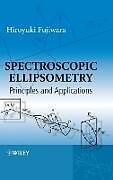Spectroscopic Ellipsometry
Einband:
Fester Einband
EAN:
9780470016084
Untertitel:
Principles and Applications
Genre:
Chemie
Autor:
Hiroyuki Fujiwara
Herausgeber:
Wiley
Anzahl Seiten:
392
Erscheinungsdatum:
12.03.2007
ISBN:
978-0-470-01608-4
Ellipsometry is a powerful tool used for the characterization of thin films and multi-layer semiconductor structures. This book deals with fundamental principles and applications of spectroscopic ellipsometry (SE).
Autorentext
Dr Hiroyuki Fujiwara is based at the National Institute of Advanced Industrial Science and Technology, Ibaraki, Japan. He received his PhD at the Tokyo Institute of Technology in 1996 and carried out post-doctoral research with Professor R.W. Collins at Penn State University. From 1998 to present he has been working as a senior research scientist at the Research Center for Photovoltaics at NIAIST. He received the 'Most Promising Young Scientist Award' from the Japan Society of Applied Physics and the 'Young Researcher Award' at the World Conference on Photovoltaic Energy Conversion in 2003.
Klappentext
Spectroscopic ellipsometry has established its position as a high-precision optical-characterization technique -- nevertheless, the principles of ellipsometry are often said to be difficult, partly due to the lack of proper knowledge for polarized light used as a probe in ellipsometry. The objective of this book is to provide a fundamental understanding of spectroscopic ellipsometry particularly for researchers who are not familiar with the ellipsometry technique. Although some aspects of the technique are complicated, the understanding is not essentially difficult, if one comprehends the principles in order. Based on this point of view, this highly-illustrated book provides general descriptions for measurement and data analysis methods employed widely in spectroscopic ellipsometry. In order to comprehend spectroscopic ellipsometry, however, a fundamental knowledge for optics is required. In the book, therefore, "Principles of Optics" and "Polarization of Light" are described (Chapters 2 and 3). From these two chapters, the principles of spectroscopic ellipsometry presented in Chapter 4 can be understood more easily. The author focuses on data analysis in the next few chapters: in particular, the principles and physical backgrounds of ellipsometry analysis are discussed in detail in Chapter 5. Since there is growing interest for optical anisotropy, the data analysis of anisotropic materials is explained in Chapters 6 and the subsequent chapter presents examples of ellipsometry analyses for various materials used in different fields are described. In the final chapter, the applications of spectroscopic ellipsometry for growth monitoring and feedback control of processing are addressed. This book will be appropriate as a text for students as well as researchers, in institutes and industrial laboratories, in providing practical information on the applications of spectroscopic ellipsometry.
Inhalt
Foreword.Preface.Acknowledgments.1 Introduction to Spectroscopic Ellipsometry.1.1 Features of Spectroscopic Ellipsometry.1.2 Applications of Spectroscopic Ellipsometry.1.3 Data Analysis.1.4 History of Development.1.5 Future Prospects.References.2 Principles of Optics.2.1 Propagation of Light.2.2 Dielectrics.2.3 Reflection and Transmission of Light.2.4 Optical Interference.References.3 Polarization of Light.3.1 Representation of Polarized Light.3.2 Optical Elements.3.3 Jones Matrix.3.4 Stokes Parameters.References.4 Principles of Spectroscopic Ellipsometry.4.1 Principles of Ellipsometry Measurement.4.2 Ellipsometry Measurement.4.3 Instrumentation for Ellipsometry.4.4 Precision and Error of Measurement.References.5 Data Analysis.5.1 Interpretation of (PSI, DELTA).5.2 Dielectric Function Models.5.3 Effective Medium Approximation.5.4 Optical Models.5.5 Data Analysis Procedure.References.6 Ellipsometry of Anisotropic Materials.6.1 Reflection and Transmission of Light by Anisotropic Materials.6.2 Fresnel Equations for Anisotropic Materials.6.3 4x4 Matrix Method.6.4 Interpretation of (PSI, DELTA) for Anisotropic Materials.6.5 Measurement and Data Analysis of Anisotropic Materials.References.7 Data Analysis Examples.7.1 Insulators.7.2 Semiconductors.7.3 Metals/Semiconductors.7.4 Organic Materials/Biomaterials.7.5 Anisotropic Materials.References.8 Real-Time Monitoring by Spectroscopic Ellipsometry.8.1 Data Analysis in Real-Time Monitoring.8.2 Observation of Thin-Film Growth by Real-Time Monitoring.8.3 Process Control by Real-Time Monitoring.References.Appendices.1 Trigonometric Functions.2 Definitions of Optical Constants.3 Maxwell's Equations for Conductors.4 Jones-Mueller Matrix Conversion.5 Kramers-Kronig Relations.Index.

Leider konnten wir für diesen Artikel keine Preise ermitteln ...
billigbuch.ch sucht jetzt für Sie die besten Angebote ...
Die aktuellen Verkaufspreise von 6 Onlineshops werden in Realtime abgefragt.
Sie können das gewünschte Produkt anschliessend direkt beim Anbieter Ihrer Wahl bestellen.
Loading...
Die aktuellen Verkaufspreise von 6 Onlineshops werden in Realtime abgefragt.
Sie können das gewünschte Produkt anschliessend direkt beim Anbieter Ihrer Wahl bestellen.
| # | Onlineshop | Preis CHF | Versand CHF | Total CHF | ||
|---|---|---|---|---|---|---|
| 1 | Seller | 0.00 | 0.00 | 0.00 |
